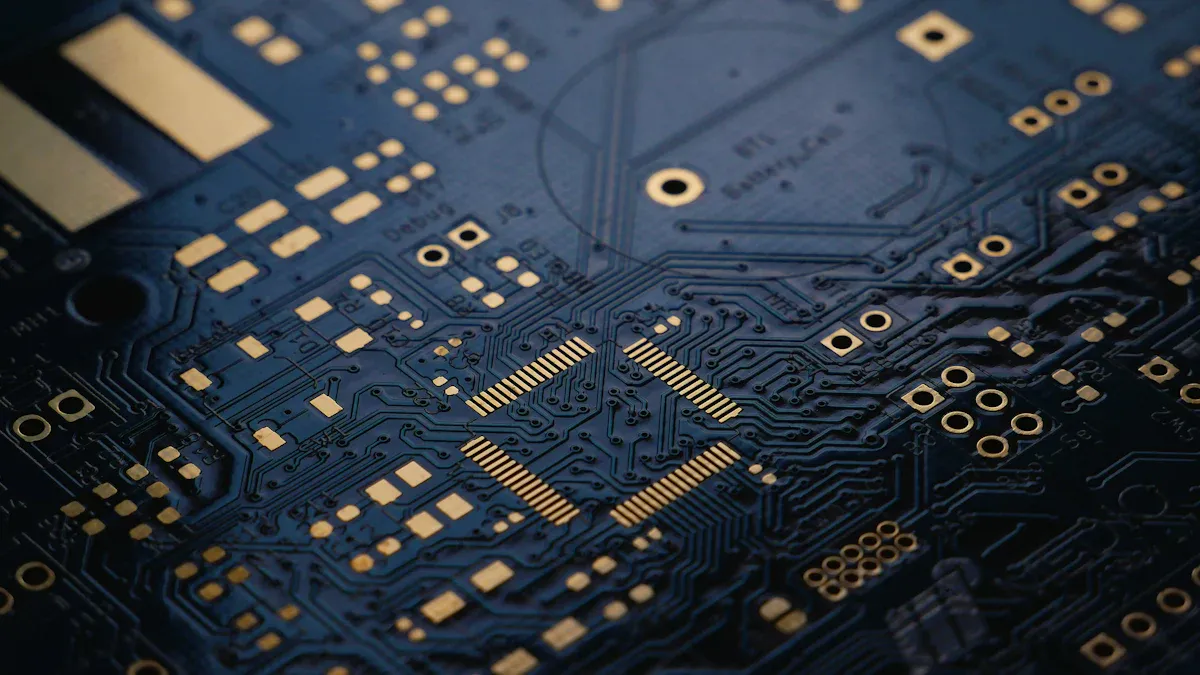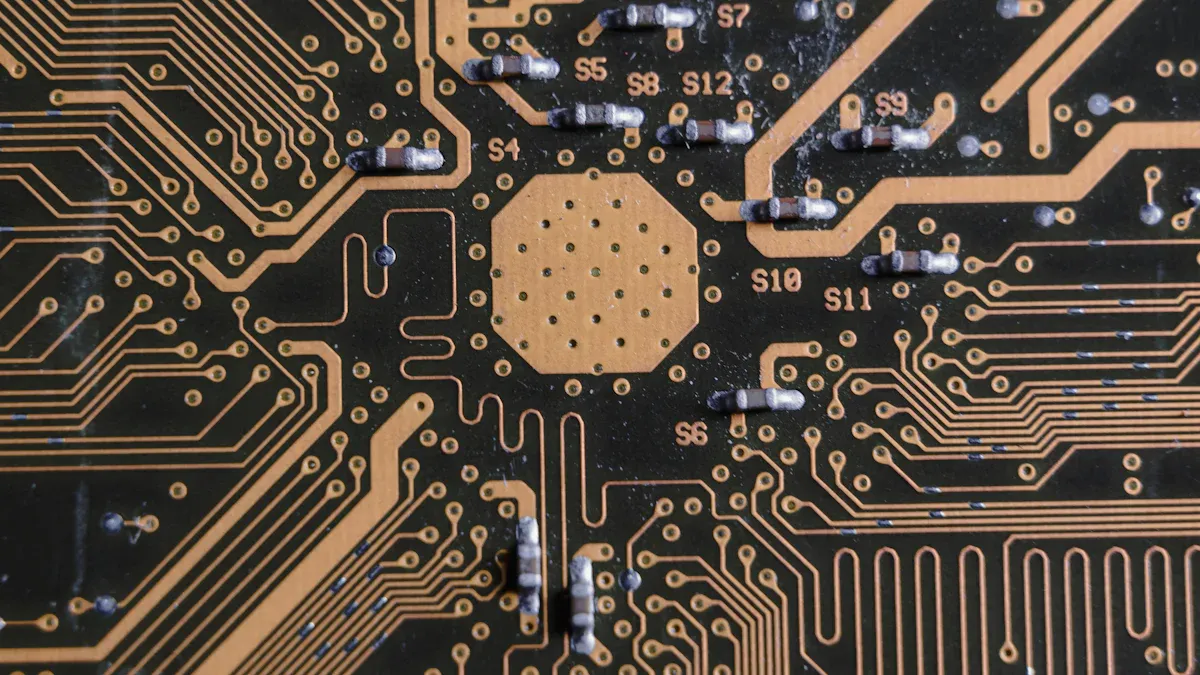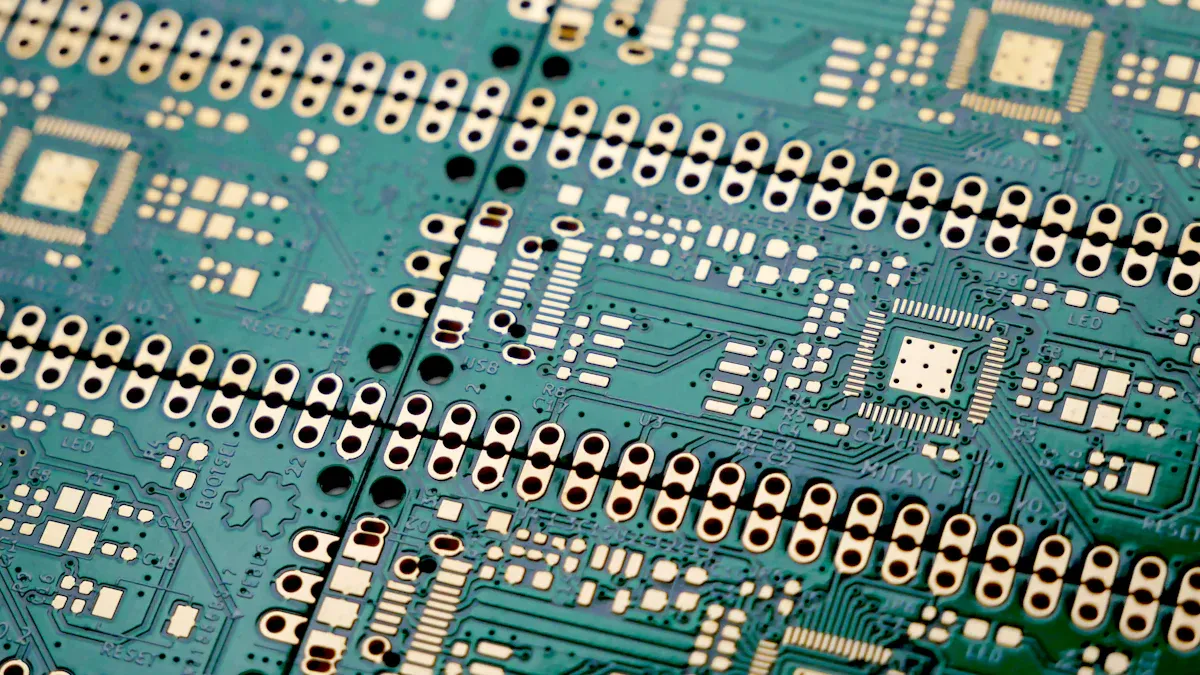Why Immersion nickel is required before Immersion gold on the surface finish of a PCB

Immersion nickel is needed before putting immersion gold on a PCB. The nickel layer works like a wall. It stops copper from moving to the top. It also helps the gold stick well. ENIG finishes at LT CIRCUIT use the right nickel thickness. This gives strong and steady PCB surfaces for all kinds of PCB finishes and pads.
Key Takeaways
Immersion nickel is a strong barrier. It stops copper from touching the gold layer. This keeps copper from rusting. It also keeps the PCB safe and strong.
The nickel layer makes a smooth and flat surface. This helps soldering work better. It also helps solder joints stay strong for a long time.
If you skip nickel or use too little, the PCB finish gets weak. This can cause problems when soldering. It also makes the PCB not last as long. So, the right amount of nickel is very important for good performance.
Immersion Nickel in PCB

Barrier Layer Function
Immersion nickel is very important in PCB surface finishes. This layer goes between the copper pads and the immersion gold. It acts like a strong wall. Its main job is to stop copper from moving into the gold. If there is no nickel, copper can get into the gold. This makes the surface lose its protection and causes oxidation. Oxidation can make the finish weak and shorten the PCB’s life.
Tests from chemical monitoring systems show that keeping the nickel bath just right is important. The nickel amount and pH must stay steady. This helps make a smooth nickel layer. It stops problems like "black nickel," which can hurt soldering and the barrier. Studies also show the nickel blocks tiny holes and keeps ions away from copper. But the nickel layer must stay whole to work well. If it breaks, copper can get through and the finish will not last.
Experts use tests like SERA to check the nickel barrier. These tests look for holes and dirt that can hurt the finish and soldering. When the nickel is controlled well, it keeps copper safe and the gold pure. LT CIRCUIT uses good immersion nickel in making PCBs. Careful control gives strong finishes and pads that last a long time.
Note: PCB surface finishes protect copper, help with soldering, and make sure connections work well. Immersion nickel is a big part of this protection.
Solderability and Adhesion
Solderability is very important for any PCB surface finish. The nickel layer in ENIG and other finishes gives a smooth, flat place for soldering. This layer is usually 3 to 7 microns thick. It gives a strong base for solder joints and stops copper from rusting. Nickel also stops weak compounds from forming that can make solder joints break easily.
The nickel layer in ENIG makes the PCB stronger and helps with soldering.
Nickel stops copper from rusting, so pads stay good for soldering.
A thin gold layer covers the nickel to stop it from rusting before use, so the surface is ready for soldering.
The gold also helps the PCB last longer and gives a flat spot for small parts.
ENIG is used a lot in things like airplanes and military electronics. This finish is tough and great for soldering, which is needed for putting on parts. The nickel bath has phosphorus, which helps stop rust and lets the finish handle many heating cycles. Nickel and gold together make a flat, smooth surface that is good for careful soldering and tight designs.
LT CIRCUIT uses good controls to make sure each PCB gets the right nickel thickness. This careful work gives finishes that stick well, make strong solder joints, and last a long time. When picking a PCB finish, engineers often choose ENIG or electroless nickel electroless palladium immersion gold because they work well and are good for soldering.
ENIG Process and Gold Layer

Electroless Nickel Immersion Gold
The electroless nickel immersion gold process puts two metal layers on the pcb. First, a chemical reaction adds a nickel layer to the copper pads. This nickel makes the surface smooth and flat. Then, a thin gold layer goes on top of the nickel. Gold is not put right on copper. If it was, copper would mix with gold and cause problems like oxidation. The nickel layer stops copper from touching the gold and keeps the surface safe.
ENIG pcb surface finish has many good points. The nickel layer stops copper from moving and keeps it from rusting. The gold layer is very thin, about 0.05 to 0.2 micrometers thick. It helps electricity flow well and keeps the pcb from rusting. ENIG finishes make the surface flat and even. This is good for tiny parts and wire bonding. These finishes also work with lead-free assembly and plated through holes. LT CIRCUIT checks each pcb carefully. They look at the surface and measure the thickness to meet IPC rules.
Benchmark Aspect | Description |
|---|---|
Gold Layer Thickness | Kept between 1 to 3 microinches for good protection and soldering. |
Nickel Underlayer | Stops copper from moving and keeps away black pad problems. |
Solderability | ENIG gives strong solder joints and helps the pcb last longer. |
Uniformity | Makes sure the pcb works the same everywhere on its surface. |
Gold’s Protective Role
The gold layer helps protect the nickel and copper under it. Gold does not rust, so it keeps air and water away from the nickel. Even though the gold layer is thin and has tiny holes, it still helps stop rust. Studies show the gold layer can fill in small cracks and give more protection to the pcb. But, the gold only works well if the nickel layer is good and the process is done right.
ENIG finishes make pcb surfaces stronger and work better. Research shows that ENIG-finished pcb parts do not rust easily. They can also be changed for special uses, like adding nanoparticles for sensors. These things make ENIG good for high-tech jobs. LT CIRCUIT uses the ENIG process to make strong pcbs with good soldering and pads that last a long time. The company also has electroless nickel electroless palladium immersion gold for even more protection and better performance.
Picking the right pcb surface finish is important. It helps protect copper, makes soldering easier, and keeps connections working well. LT CIRCUIT knows a lot about ENIG and electroless nickel electroless palladium immersion gold. This helps customers get the best results for their pcb designs.
Skipping Nickel: Risks
Reliability Issues
If you skip the immersion nickel layer in ENIG, big problems can happen. The nickel layer acts like a wall between gold and copper. Without it, gold can mix with copper. This can cause a problem called "black pad." Black pad makes the surface weak. The PCB might stop working if this happens. The nickel layer is usually 3 to 6 microns thick. If it is less than 3 microns, it is too thin. Then, copper and solder can mix and make weak spots. Solder joints will not be strong. If you skip nickel or use too little, solder joints can break more easily.
Engineers say that too much nickel, over 6 microns, is also bad. It can make solder joints hard and easy to crack. This hurts how long the PCB lasts.
Performance Impact
Not using immersion nickel in ENIG hurts how the PCB works. Gold alone cannot keep copper from rusting. It also cannot keep signals working right. If gold touches copper, the surface is not flat. This makes it hard to put on small parts. It can also make weak connections. ENIG needs the nickel layer to keep the surface strong. Without nickel, the finish cannot protect the PCB. The board may not pass important tests.
Not using nickel makes rust more likely.
The surface can get problems that make the PCB wear out faster.
Solder joints might break, so devices can stop working.
Companies like LT CIRCUIT always use the nickel step. This helps every PCB meet tough quality rules.
ENIG is a top choice for pcb surface finishes because it works well and lasts long. The immersion nickel layer keeps the pcb safe and helps the gold layer stay on. LT CIRCUIT checks each pcb carefully to make sure it is made right. ENIG gives a smooth surface, lasts a long time, and makes strong solder joints.
Surface Finish | Shelf Life | Corrosion Risk | Solderability |
|---|---|---|---|
ENIG | No | Good | |
OSP | Under 12 Months | Yes | Good |
Picking ENIG means your pcb will last longer and work well, even when used in tough places.
FAQ
What happens if a PCB skips the nickel layer before gold?
If you do not use the nickel layer, copper can mix with gold. This makes the surface weak. Soldering can be hard. The PCB might stop working sooner.
How thick should the immersion nickel layer be in ENIG?
The nickel layer needs to be 3 to 7 microns thick. This keeps solder joints strong. It also protects the copper pads well.
Why do engineers prefer ENIG for advanced PCBs?
ENIG makes the surface flat and smooth.
It helps solder stick better.
The finish stops rust and works for tiny parts.
See Also
Why Immersion Gold Outperforms Other PCB Surface Finishes
How Tin Immersion Affects Stability Of PCB Solder Masks
The Importance Of Gantry Electroplating For Half-Hole PCBs
OSP Finish Explained: Advantages, Drawbacks, And Manufacturing Tips
Comprehensive Guide To Heavy Copper Multilayer PCB Production
